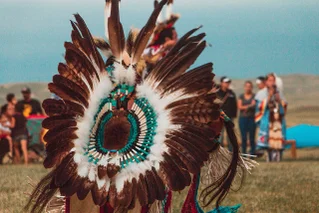
How Native Communities Work Together During Crises
An inside look at community struggles and the power of working together.
Whether it’s tackling a severe weather emergency or reducing risk amid a global health pandemic, reservation communities face unique barriers to disaster aid and emergency response. Year-round realities such as food insecurity and contaminated water, overcrowded housing, lack of internet access and health care make navigating an emergency even more complex for tribal communities, especially those located on remote and impoverished reservations.
These tribes are all too familiar with the short and long-term effects of a disaster, as many remote communities frequently face weather emergencies. Preparedness is critical for impoverished Native communities, where even daily life can feel like a crisis, and disaster recovery typically takes longer on the reservations than it does in mainstream America due to a lack of resources.
Tamee Livermont, MPH, citizen of the Oglala Lakota Nation, shares insight on the ongoing struggles these communities face and finding hope through working together.
The Impact of COVID-19 on Native Communities
Pandemics and disease are far too familiar to Native American communities. The intentional introduction of smallpox into Native communities was one of our earliest introductions to the dangers that new viruses can present.
The COVID-19 virus has disparately impacted Native Americans. American Indians make up 12% of COVID-19 cases in South Dakota as compared to 9% for the American Indian and Alaska Native (AI/AN) population according to the 2010 U.S. Census. 18% of the state's deaths are AI/AN. Data from March 1 - June 27, 2020 show American Indian/Alaska Native people hospitalized from COVID more than all other racial groups.
Historical precedent has made our relatives and communities at greater risk for adverse outcomes from COVID-19. The impacts of historical trauma, an artifact of traumas experienced in our communities through the federal government's efforts to "kill the Indian, save the man," and the chronic underfunding of healthcare and public health efforts in tribal communities have contributed to the rampant health disparities in tribal communities. Many of these are comorbidities associated with higher rates of mortality among COVID-19 patients.
Native Community in Crisis
The housing crisis in Indian Country is on full display as it is not uncommon to have ten or more people living in a home on many reservations. However, multigenerational living situations make quarantine or isolation hard. Preventing the spread of COVID in a household once one family member is ill is impossible. The rural nature of many reservations has built a supply chain that is subpar on a good day—add a pandemic to the equation, and you can imagine the disastrous effect. In urban areas, poverty and homelessness make caring for and isolating COVID-positive individuals challenging. When essential services such as drug and alcohol treatment programs, food delivery services, and other social service programs closed their doors during the pandemic, our community had little to nowhere to turn.
Hope for the Future of Native Communities
Our forward-thinking leadership identified gaps and, in the same breath, were identifying solutions. We received a grant to stand up one of the first-ever tribal Emergency Operations Center (EOC) that serves 17 tribal nations and one service unit over a 4-state area. Since, we have been serving the tribes, providing emergency response training, filling gaps in the supply chain and accessing essential PPEs, and providing food and cleaning supplies to families impacted by COVID. Grants from the Center for Disaster Philanthropy, the CDC, and other organizations are supporting pandemic related EOC efforts as well as assisting us in preparation for COVID-19 recovery and work towards more organized and responsive disaster recovery in Tribes across the Great Plains Area.
Had Tribal Nations, Indian Country generally, Tribal Organizations, and allies who stepped up during the pandemic not taken the actions they did, I anticipate these disparities would be much broader. Providing Tribal Nations support for capacity building in emergency management and public health is of utmost importance in our ability to respond to the needs of and protect our communities and relatives. Empowering self-governance and sovereign rights of tribal nations will continue to provide an opportunity to protect our people and restore for the next 7 generations to come.
Written by Tamee Livermont, MPH, citizen of the Oglala Lakota Nation, is the Tribal Liaison for the Great Plains Tribal Leaders Health Board (GPTLHB). GPTLHB is dedicated to serving the health and wellness needs of the tribal members it represents. Assisting with the needs of 18 tribes and tribal communities in the four-state region of South Dakota, North Dakota, Nebraska and Iowa, GPTLHB addresses the health necessities of its members by assisting in accessing health-related programs and resources. For more information visit https://www.gptchb.org.





